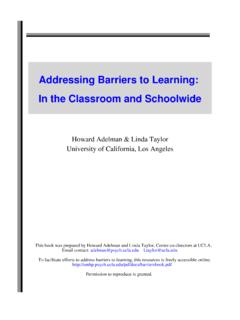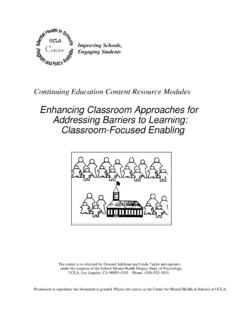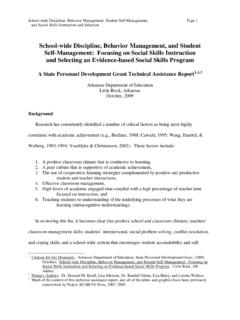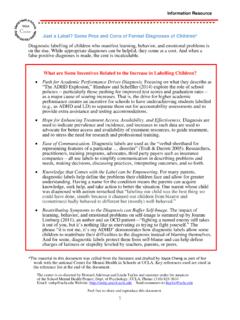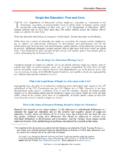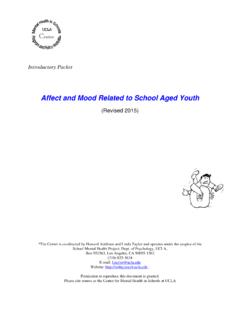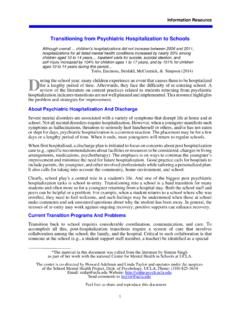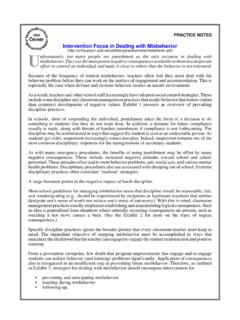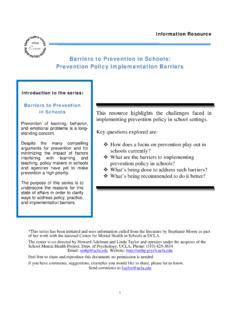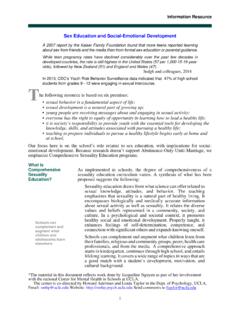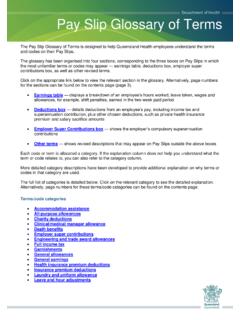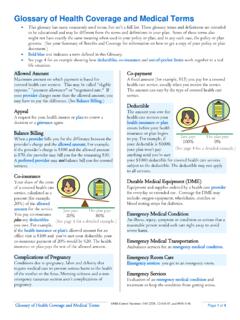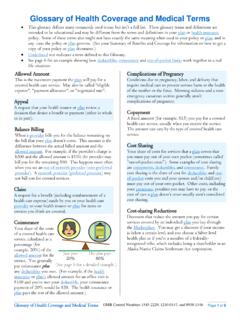Transcription of GLOSSARY OF KEY TERMS, ACRONYMS, AND LAWS
1 GLOSSARY OF KEY TERMS, ACRONYMS, AND LAWS. Those interested in psychosocial and mental health concerns encounter a host of specialized terms, acronyms, and references to legislation. On the following pages, you will find a brief resource aid and references to the sources from which they were drawn should you want to pursue more extensive glossaries. Included here are: Excerpts from: American Psychiatric GLOSSARY (seventh edition; 1994) published by the American Psychiatric Press (Washington, DC). a GLOSSARY of acronyms and laws related to emotional and behavior disorders compiled by the Institute for Adolescents with Behavioral Disorders, Arden Hills, MN.
2 Also included is a copy of Children's and Adolescents' mental health : A GLOSSARY of Terms prepared and circulated by the Dept. of health and Human Services, Substance Abuse and mental health Services Administration) Center for mental health Services Some Key Tern s Related to mental health and Psychosocial Problems The following is a sampling of key terms from the American Psychiatric GLOSSARY (7th edition, edited by Jane Edgerton and Robert Campbell, III [1994]. Washington, DC-. American Psychiatric Press, Inc.). It provides a user-friendly definition for quick referral. For a more extensive listing of terms, see the original source.
3 Abnormality In psychological terms, any mental , emotional, or behavioral activity that deviates from culturally or scientifically accepted norms. abreaction Emotional release or discharge after recalling a painful experience that has been repressed because it was not consciously tolerable (see conscious). A therapeutic effect sometimes occurs through partial or repeated discharge of the painful affect. See also systematic desensitization. academic disorders In DSM-IV, this is a major group of infancy, childhood, and adolescence disorders that includes reading disorder, mathematics disorder, and disorder of written expression.
4 Acculturation difficulty A problem in adapting to or finding an appropriate way to adapt to a different culture or environment. The problem is not based on any coexisting mental disorder. acting out Expressions of unconscious emotional conflicts or feelings in actions rather than words. The person is not consciously aware of the meaning of such acts (see conscious). Acting out may be harmful or, in controlled situations, therapeutic ( , children's play therapy). adaptation Fitting one's behavior to meet the needs of one's environment, which often involves a modification of impulses, emotions, or attitudes.
5 Adjustment Often transitory functional alteration or accommodation by which one can better adapt oneself to the immediate environment and to one's inner self See also adaptation. adjustment disorder An imprecise term referring to emotional or behavioral symptoms that develop in response to an identifiable stressor. The symptoms, which may include anxiety, depressed mood, and disturbance of conduct, are clinically significant in that the distress exceeds what would be expected under the circumstances, or significant impairment in social or occupational functioning is produced. Duration of symptoms tends to be self-limited, not persisting more than 6 months after termination of the stressor or its consequences.
6 Sometimes the disorder is designated as "acute" if duration is 6. months or less, and as "persistent" or "chronic" if symptoms endure beyond 6 months. affect Behavior that expresses a subjectively experienced feeling state (emotion); affect is responsive to changing emotional states, whereas mood refers to a pervasive and sustained emotion. Common affects are euphoria, anger, and sadness. Some types of affect disturbance are: blunted Severe reduction in the intensity of affective expression. flat Absence or near absence of any signs of affective expression such as a monotonous voice and an immobile face.
7 Inappropriate Discordance of voice and movements with the content of the person's speech or ideation. labile Abnormal variability, with repeated, rapid, and abrupt shifts in affective expression. restricted or constricted Reduction in the expressive range and intensity of affects. affective disorder A. disorder in which mood change or disturbance is the primary manifestation. Now referred to as mood disorder. See depression. aggression Forceful physical, verbal, or symbolic action. May be appropriate and self-protective, including healthy self-assertiveness, or inappropriate as in hostile or destructive behavior.
8 May also be directed toward the environment, toward another person or personality, or toward the self, as in depression. agitation Excessive motor activity, usually nonpurposeful and associated with internal tension. Examples include inability to sit still, fidgeting, pacing, wringing of hands, and pulling of clothes. See psychomotor agitation. agoraphobia Anxiety about being in places or situations in which escape might be difficult or embarrassing or in which help may not be available should a panic attack occur. The fears typically relate to venturing into the open, leaving the familiar setting of one's home, or of being in a crowd, standing in line, or traveling in a car or train.
9 Although agoraphobia usually occurs as a part of panic disorder, agoraphobia without a history of panic disorder has been described. Alcohol, Drug Abuse, and mental health Administration (ADAMHA) An agency in the Department of health and Human Services that was replaced in 1992 by the Substance Abuse and mental health Services Administration (SAMHSA). In reorganizing ADAMHA into SAMHSA, the three ADAMHA research institutes, the National Institute on Alcohol Abuse and Alcoholism (NIAAA), the National institute on Drug Abuse (NIDA), and the National Institute of mental health (NIMH), were moved to the National Institutes of health .
10 What remains in SAMHSA are the substance abuse and mental health services programs. alcohol use disorders In DSM-IV, this group includes alcohol dependence, alcohol abuse, alcohol intoxication, alcohol withdrawal, alcohol delirium, alcohol persisting dementia, alcohol persisting amnestic disorder, alcohol psychotic disorder, alcohol mood disorder, alcohol anxiety disorder, alcohol sleep disorder, and alcohol sexual dysfunction. See abuse, substance; dependence, substance; intoxication, alcohol, withdrawal symptoms, alcohol. ambivalence The coexistence of contradictory emotions, attitudes, ideas, or desires with respect to a particular person, object, or situation.
